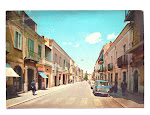-
Welcome to our blog, Genzano it story
and our post, Compare farming part 2
-
When I was young there were already in use this harvesters they were horse drawn devises that would cut the wheat and tie it in bundles.
This is the very old way of harvesting fields of wheat a man with a sickle, you needed a gang of man to harvest a small field.
Harvesting the very old way
This link above is the link to our hub pages, where this article has more photos to see.
Dear readers, this post is the continuation
of our last post Compare farming, so you need to read our last post first, in
order to follow what we are saying here; you see we would like to compare the
old ways of farming with today farming, therefore, we need to say at least
briefly how harvesting wheat was done the old ways; here we need to say also
that I have personally witnessed the last part of this old practice when I was
young. You see, when I was young we were already using a horse drawn harvester,
and it was very helpful; but there were people that had some very small
holdings and we had one of these ourselves, so we had to use the old ways of
harvesting our wheat for that small wheat field, because that was the only way
to do it, as it was hard or almost impossible to take any machines there for
one reason or another.
So, let me describe how harvesting was done
in those old bygone days; at harvesting time strange as it may seem today, one
could hire some specialized people that were good at using the sickle, these
people usually went from town to town to do this seasonal harvesting job; here
we need also to explain that in Southern Italy because the terrain has
different altitude the wheat reaches maturity at different times, this geographic
position was helping these seasonal workers to have a longer span of work, so
they would go from town to town until the harvesting season would finish completely.
Now just to compare those very hard times with today times, I have to tell you
that these workers were sleeping anywhere they could on a sack filled up with
straws under a shelter if they could find one, as they could not afford
anything else. In the morning if they had already been hired they would get up
early and go where they had to go to work, if not they would wait in the town
square hoping that somebody would hire them for the day.
Now let us say that we had a small plot
about one acre and we could not use the harvester of those time, because it was
not possible to go there, we would then hire four people and form a gang that
could harvest one acre in one day and collect it in hips that would be later on
taken on a cart to the farm house to be threshed one way or another.
In the old times anything that had grown in
the field was collected, it needed to be collected for the people to survive,
it was the only way because the fields did not produce as much as they do
today, because they could not be cultivated as good as we do today.
Now I suppose I have to say briefly how the
older generations used to thresh their harvests, in order to collect all their
produce. Now, let us suppose that it was only a few bundles of wheat to be
threshed one could even extract the wheat by hitting them with a stick, but let
us say that we had a cartful, or many cartfuls for that matter, then we had to
use a different method, which is the way that most farm used in the very old
times for centuries, so let me tell you how it was done.
I happen to know this procedure, because in
the farms when I was young we were still using this method with smaller crops
most likely broad beans, lentils, chick peas, linseed, and other farm produce,
and the elder would always be telling us that this was the way that they used
to collect their wheat as well and usually it took them a few months to collect
all the season produce. So now let me describe this to you, so that we would be
able to compare the great difference.
In order to do this, first of all we needed
to prepare a piece of ground that is very solid and smooth, this could be
achieved by stripping the old dry grass on a piece of land that had a large
clay content, then wet it with a little bit of water to make it compact; once
that was ready we would place our wheat or whatever was to be threshed and
collected on this clean ground, then we would get our horses mule and donkeys
whatever animals were available and drive them around and around until
everything was threshed. Of course there was a lot more to say, but let us make
it short otherwise it would become too boring.
Now, once the threshing was done we has to
separate the produce from the straw and any other foreign matter, this was
achieved by removing the straws from the top layer making sure that no produce
was left with the straws, at the same time we would collect the bottom layer in
a hip, once that was done we would have to clean that produce by using the
wind, to take away the finer parts that were still mixed with the wheat or whatever
it was, and there were many other things that we could use to get this wheat
clean, by the end of the day we could have collected two or three hundred
kilograms of produce.
In the very ancient times was even worse,
see what they were using in the Medieval Times, here is a link to check out
some ancient farm tools including the Flail and Winnowing Basket used to
collect and clean wheat.
I hope that this gives the modern reader a
view of how thing were done in the old times, so I do not want to say much more
about how all this threshing and cleaning of the wheat was done, because even
writing about it is boring today, but anyhow it needed to be done in those
days, because that was the only way to collect our wheat to make bread and
other things. Now, my dear reader’s do you see how hard was then even to
collect wheat for ourselves.
I hope I have been able to write something
that really sets up the great difference of the ways of life that we were
living then and the ways of life that we are living now, for this I want you to
compare and judge for yourself how much better off we are today.
To the young people who think that today
life is hard, let me describe to you what I have witnessed when I was young,
because then life really was harder then today, you see those days everybody
had to find how to earn enough to feed themselves there were no handover from
the government. So, the very poor people of those days were trying to collect
anything they could to feed themselves.
So at harvest time this is what I have
witnessed, I have seen old and poor people mainly old ladies go around the
fields and pick up any ear of wheat that was left behind in the fields, one ear
of wheat here and anther there until
they had the strength, each day until harvest time was over and there was
nothing else to collect; and I tell you what these poor people were happy if in
the end they had collected enough ears of wheat that they could trash and clean
themselves, perhaps they could have collected enough to make 50 to 100 kilos of
wheat during harvest time and they were happy because, they could make bread
from this wheat and not go hungry for a few months.
Now I hope that you see what I mean when I
say that the youths of today don’t know anything about hard times?
---------------------------------------
---------------------------------------------------
Genzano it story
Compare farming part 2
IS
GOING TO BE CONTINUED;
Next
time with, a different story
-------------------------------------------
Some
useful links
Some hub links




















